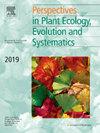个体发育揭示了亚马逊豆科树的花分化单种属Uleanthus的花发育和进化
IF 2.9
3区 环境科学与生态学
Q1 ECOLOGY
Perspectives in Plant Ecology Evolution and Systematics
Pub Date : 2025-06-14
DOI:10.1016/j.ppees.2025.125887
引用次数: 0
摘要
花的个体发生是比较生物学中理解花形态多样性及其进化途径的最有力工具之一。亚马逊地区的单一树种Uleanthus(豆科,凤蝶科)以其引人注目的蜂鸟授粉的花朵而闻名,其花萼为鲜红色,标准花瓣为粉红色至淡紫色,形成管状结构,包裹着生殖器官。对黄花菊的个体发育揭示可能有助于阐明其有争议的系统发育定位,并有助于阐明在形态相似但进化距离较远的和形态不同但系统发育接近的乳突豆科植物谱系中更广泛的花同源性和趋同模式。在田间采集不同发育阶段的花蕾,在70% %乙醇中保存,用扫描电镜(SEM)观察花的个体发生。结果与现有的推测密切相关的千花科豆科属的资料进行了广泛的比较。赤竹草的萼片以单向顺序出现。花瓣同时启动;先祖雄蕊和先祖雄蕊的起始是单向的。心皮起始与第一个雄蕊原基同时发生。与其他鸟类传粉的凤蝶属之间的明显相似性并不支持花的个体发生,而是它们进化趋同。尽管乌莲花的花结构与其被认为在系统发育上与Genistoid分支密切相关的Camoensia形成了鲜明的对比,但两者都有相似的花,具有艳丽的标准和未分化的内花瓣,这在个体发育的早期得到了证实。本文章由计算机程序翻译,如有差异,请以英文原文为准。
Ontogeny unlocks the floral development and evolution of Uleanthus, a florally divergent monospecific genus of Amazonian legume trees
Floral ontogeny is one of the most powerful tools in comparative biology for understanding the diversity of flower forms and their evolutionary pathways. The Amazonian monospecific tree genus Uleanthus (Leguminosae, Papilionoideae) stands out for its striking hummingbird-pollinated flowers with a bright red calyx and pink to lilac standard petal forming a tubular structure that encloses the reproductive organs. Ontogenetic revelations of Uleanthus erythrinoides may shed light on its controversial phylogenetic placement and help to elucidate broader patterns of floral homology and convergence among morphologically similar yet evolutionarily distant, and morphologically contrasting but phylogenetically close lineages within papilionoid legumes. Flower buds were collected in different developmental stages in the field, and stored in 70 % ethanol to investigate the floral ontogeny using scanning electron microscopy (SEM). Results were broadly compared with existing material from putatively closely related papilionoid legume genera. Sepals of Uleanthus erythrinoides emerge with a unidirectional sequence. The petals initiate simultaneously; the antesepalous and antepetalous stamens initiate unidirectionally. The carpel initiation is concomitant with the first antesepalous stamen primordia. The apparent resemblance between Uleanthus and other bird-pollinated papilionoid genera does not bear support in floral ontogeny, rather they have evolved convergently. Despite the contrasting floral architecture of Uleanthus and its putative phylogenetically closely related Camoensia from the Genistoid clade, both share similar flower with a showy standard and undifferentiated inner petals that are verified early in the ontogenetic development.
求助全文
通过发布文献求助,成功后即可免费获取论文全文。
去求助
来源期刊
CiteScore
6.50
自引率
0.00%
发文量
28
审稿时长
67 days
期刊介绍:
Perspectives in Plant Ecology, Evolution and Systematics (PPEES) publishes outstanding and thought-provoking articles of general interest to an international readership in the fields of plant ecology, evolution and systematics. Of particular interest are longer, in-depth articles that provide a broad understanding of key topics in the field. There are six issues per year.
The following types of article will be considered:
Full length reviews
Essay reviews
Longer research articles
Meta-analyses
Foundational methodological or empirical papers from large consortia or long-term ecological research sites (LTER).

 求助内容:
求助内容: 应助结果提醒方式:
应助结果提醒方式:


